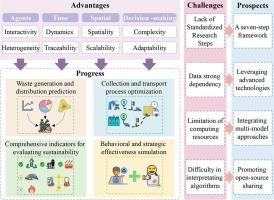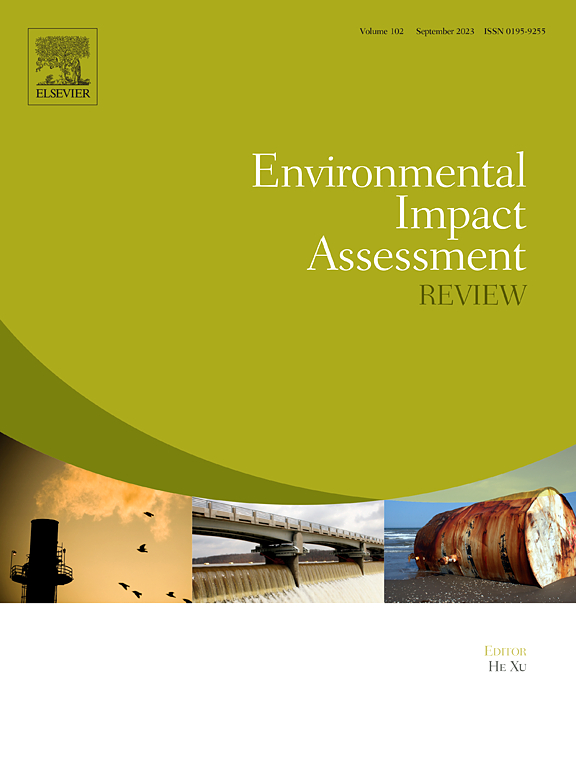Agent-based modeling in solid waste management: Advantages, progress, challenges and prospects
IF 9.8
1区 社会学
Q1 ENVIRONMENTAL STUDIES
引用次数: 0
Abstract
The growing issue of solid waste management (SWM) is recognized as a significant challenge to ecosystem preservation. Agent-based modeling (ABM) has received significant attention for its capability to address complex systems and simulate the outcomes of strategic implementation. This review compares ABM with other methods and provides a comprehensive overview of research on ABM in SWM from 2000 to 2023, emphasizing its advantages, progress, challenges, and future directions. Results indicate that: 1) ABM possesses 8 key advantages in simulating individual behavior, responses to environmental changes across time and spatial scales, and decision-making processes, namely interactivity, heterogeneity, dynamism, traceability, spatiality, scalability, complexity, and adaptability. 2) Current research primarily focuses on simulating behavioral and strategic effects of SWM (accounting for 45.5 %), while multi-model coupling is becoming a new trend. 3) ABM encounters challenges in its research, including a lack of standardized research steps, high data dependency, limited computing resources, and difficulties in algorithm explanation. Therefore, this study introduces a set of normative steps that provide clear guidance for research and help ensure the reproducibility and accuracy of studies. Future research should incorporate big data and emerging technologies to enhance computational efficiency and processing capabilities of models. To better utilize ABM for achieving environmental protection and sustainable development goals, prioritizing integration of multi-model coupling, interdisciplinary collaboration, visualization, and open-source code sharing as key strategies is essential.

基于代理的固体废物管理建模:优势、进展、挑战和前景
日益严重的固体废物管理(SWM)问题被认为是对生态系统保护的重大挑战。基于代理的建模(ABM)因其处理复杂系统和模拟战略实施结果的能力而备受关注。本综述将 ABM 与其他方法进行了比较,并全面概述了从 2000 年到 2023 年有关 SWM 中 ABM 的研究,强调了其优势、进展、挑战和未来方向。研究结果表明1) 在模拟个体行为、对跨时空尺度环境变化的响应以及决策过程方面,ABM 具有 8 个关键优势,即交互性、异质性、动态性、可追溯性、空间性、可扩展性、复杂性和适应性。2) 目前的研究主要集中在模拟全部门管理的行为和战略影响(占 45.5%),而多模型耦合正成为一种新趋势。3) ABM 在研究中遇到了一些挑战,包括缺乏标准化的研究步骤、数据依赖性高、计算资源有限、算法解释困难等。因此,本研究引入了一套规范步骤,为研究提供明确指导,有助于确保研究的可重复性和准确性。未来的研究应结合大数据和新兴技术,提高模型的计算效率和处理能力。为了更好地利用人工智能模型实现环境保护和可持续发展目标,必须优先考虑将多模型耦合、跨学科合作、可视化和开源代码共享作为关键策略。
本文章由计算机程序翻译,如有差异,请以英文原文为准。
求助全文
约1分钟内获得全文
求助全文
来源期刊

Environmental Impact Assessment Review
ENVIRONMENTAL STUDIES-
CiteScore
12.60
自引率
10.10%
发文量
200
审稿时长
33 days
期刊介绍:
Environmental Impact Assessment Review is an interdisciplinary journal that serves a global audience of practitioners, policymakers, and academics involved in assessing the environmental impact of policies, projects, processes, and products. The journal focuses on innovative theory and practice in environmental impact assessment (EIA). Papers are expected to present innovative ideas, be topical, and coherent. The journal emphasizes concepts, methods, techniques, approaches, and systems related to EIA theory and practice.
 求助内容:
求助内容: 应助结果提醒方式:
应助结果提醒方式:


